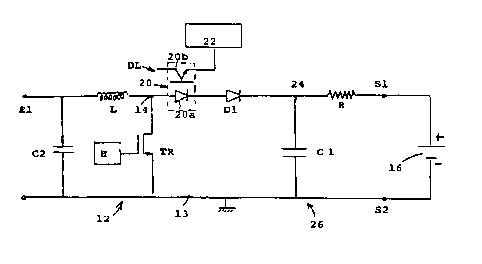Some of the information on this Web page has been provided by external sources. The Government of Canada is not responsible for the accuracy, reliability or currency of the information supplied by external sources. Users wishing to rely upon this information should consult directly with the source of the information. Content provided by external sources is not subject to official languages, privacy and accessibility requirements.
Any discrepancies in the text and image of the Claims and Abstract are due to differing posting times. Text of the Claims and Abstract are posted:
| (12) Patent Application: | (11) CA 2350664 |
|---|---|
| (54) English Title: | LOGIC INPUT CIRCUIT WITH ENERGY TRANSFER AND ADAPTABLE IN INPUT VOLTAGE |
| (54) French Title: | CIRCUIT LOGIQUE D'ENTREE A TRANSFERT D'ENERGIE ET ADAPTABLE EN FONCTION DE LA TENSION D'ENTREE |
| Status: | Deemed Abandoned and Beyond the Period of Reinstatement - Pending Response to Notice of Disregarded Communication |
| (51) International Patent Classification (IPC): |
|
|---|---|
| (72) Inventors : |
|
| (73) Owners : |
|
| (71) Applicants : |
|
| (74) Agent: | ROBIC AGENCE PI S.E.C./ROBIC IP AGENCY LP |
| (74) Associate agent: | |
| (45) Issued: | |
| (86) PCT Filing Date: | 2000-09-08 |
| (87) Open to Public Inspection: | 2001-03-22 |
| Availability of licence: | N/A |
| Dedicated to the Public: | N/A |
| (25) Language of filing: | English |
| Patent Cooperation Treaty (PCT): | Yes |
|---|---|
| (86) PCT Filing Number: | PCT/FR2000/002484 |
| (87) International Publication Number: | WO 2001020414 |
| (85) National Entry: | 2001-05-09 |
| (30) Application Priority Data: | ||||||
|---|---|---|---|---|---|---|
|
The invention concerns a logic input circuit for an industrial equipment
automatic system powered by a direct current voltage source, in particular a
battery (16), comprising a voltage amplifying energy converter (12) consisting
of an inductance coil L and a switching transistor TR, connected to the input
E1 of the circuit (10); a logic level sensor DL with optocoupler (20), and a
clock circuit H controlling the transistor switching TR by adjusting the
frequency or the cyclic ratio to be adapted in voltage to the signals applied
at the input E1, and the overvoltage value generated in logic high (1) by the
inductance coil L when the transistor TR is switched off-state.
Un circuit d'entrée logique pour un automatisme d'un équipement industriel alimenté par une source de tension continue, notamment une batterie (16), comporte: un convertisseur d'énergie (12) élévateur de tension composé d'une bobine d'inductance L et d'un transistor TR de commutation, connectés à l'entrée E1 du circuit (10); un détecteur de niveau logique DL à optocoupleur (20), et un circuit d'horloge H pilotant la commutation du transistor TR par réglage de la fréquence ou du rapport cyclique pour s'adapter en tension aux signaux appliqués à l'entrée E1, ainsi que la valeur de la surtension engendrée dans l'état logique haut (1) par la bobine d'inductance L lors de la commutation du transistor TR vers l'état bloqué.
Note: Claims are shown in the official language in which they were submitted.
Note: Descriptions are shown in the official language in which they were submitted.

2024-08-01:As part of the Next Generation Patents (NGP) transition, the Canadian Patents Database (CPD) now contains a more detailed Event History, which replicates the Event Log of our new back-office solution.
Please note that "Inactive:" events refers to events no longer in use in our new back-office solution.
For a clearer understanding of the status of the application/patent presented on this page, the site Disclaimer , as well as the definitions for Patent , Event History , Maintenance Fee and Payment History should be consulted.
| Description | Date |
|---|---|
| Application Not Reinstated by Deadline | 2006-09-08 |
| Time Limit for Reversal Expired | 2006-09-08 |
| Inactive: IPC from MCD | 2006-03-12 |
| Inactive: Abandon-RFE+Late fee unpaid-Correspondence sent | 2005-09-08 |
| Deemed Abandoned - Failure to Respond to Maintenance Fee Notice | 2005-09-08 |
| Letter Sent | 2001-11-30 |
| Inactive: Single transfer | 2001-10-22 |
| Inactive: Cover page published | 2001-09-21 |
| Inactive: First IPC assigned | 2001-08-02 |
| Inactive: Courtesy letter - Evidence | 2001-07-24 |
| Inactive: Notice - National entry - No RFE | 2001-07-18 |
| Application Received - PCT | 2001-07-16 |
| Application Published (Open to Public Inspection) | 2001-03-22 |
| Abandonment Date | Reason | Reinstatement Date |
|---|---|---|
| 2005-09-08 |
The last payment was received on 2004-09-03
Note : If the full payment has not been received on or before the date indicated, a further fee may be required which may be one of the following
Please refer to the CIPO Patent Fees web page to see all current fee amounts.
| Fee Type | Anniversary Year | Due Date | Paid Date |
|---|---|---|---|
| Basic national fee - standard | 2001-05-09 | ||
| Registration of a document | 2001-10-22 | ||
| MF (application, 2nd anniv.) - standard | 02 | 2002-09-09 | 2002-08-12 |
| MF (application, 3rd anniv.) - standard | 03 | 2003-09-08 | 2003-07-30 |
| MF (application, 4th anniv.) - standard | 04 | 2004-09-08 | 2004-09-03 |
Note: Records showing the ownership history in alphabetical order.
| Current Owners on Record |
|---|
| SOPRANO |
| Past Owners on Record |
|---|
| OLIVIER FRANCOIS |
| PATRICK PIRON |
| RICHARD DREVON |